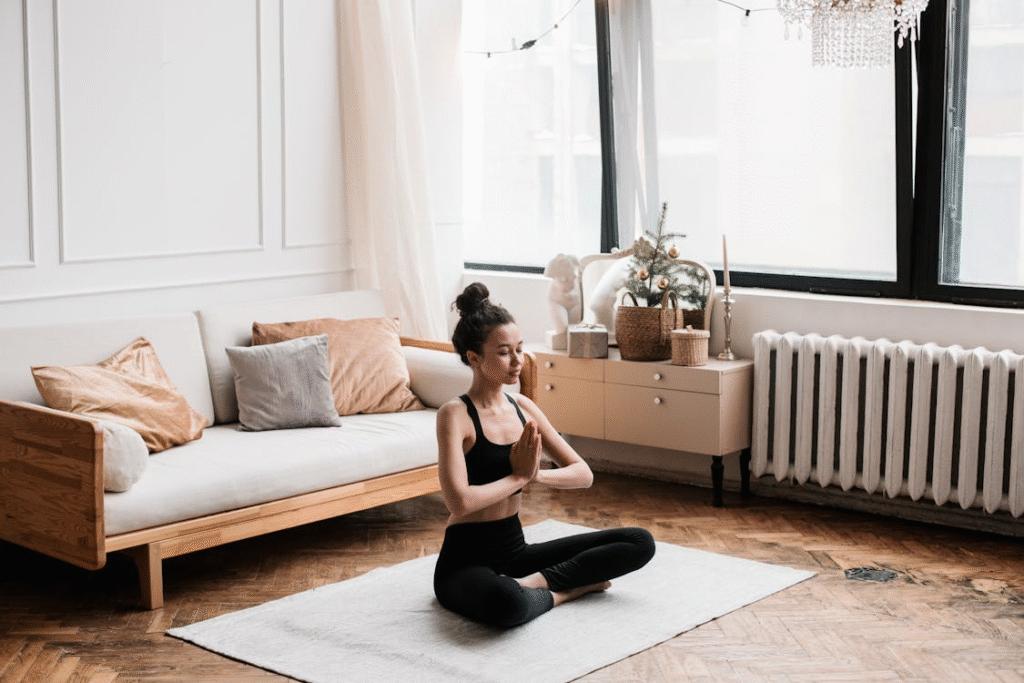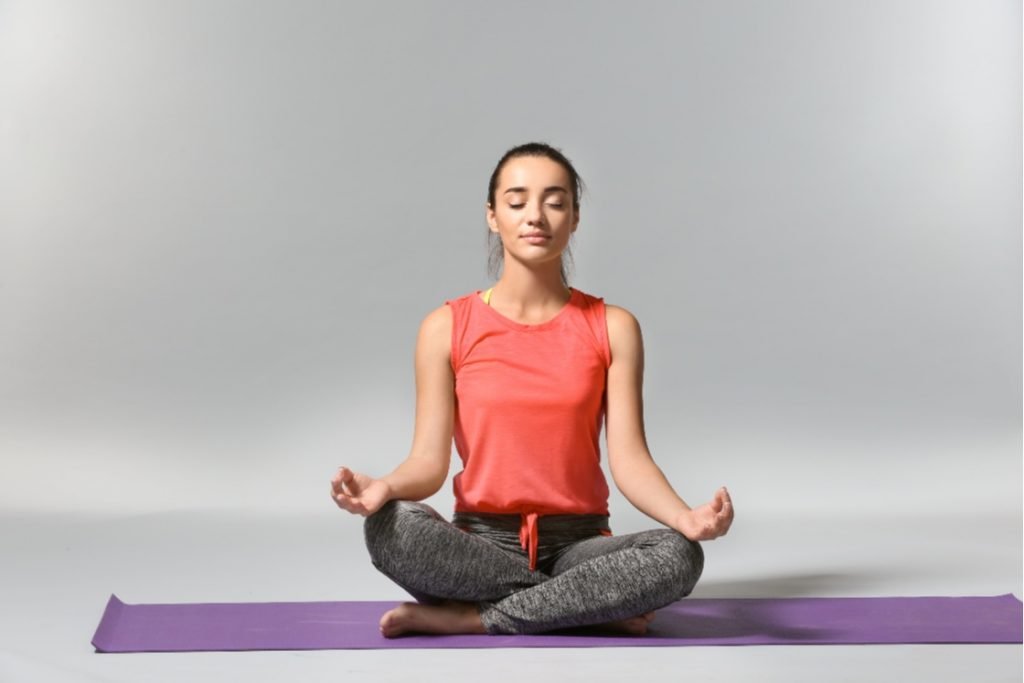No matter how hard or easy the asana is—from Sukhasana to Padmasana—each one leads to inner peace. Sit with love, begin where you are, and allow meditation to lead you home.
Finding a place within yourself where balance, clarity, and serenity spontaneously emerge is the goal of meditation, which goes beyond simply closing your eyes and remaining motionless. However, I have discovered that the posture you select (āsana) has a significant impact on your meditation experience.
I used to merely sit cross-legged at first, but in a few minutes, my back would sag, my legs began feeling pain, and I would no longer sense serenity but rather restlessness. It dawned on me then that proper meditation āsana is about alignment and comfort, not just discipline. Your mind follows your body’s relaxation.
From the most basic, like Sukhasana, to the more profound, conventional, like Padmasana, let’s examine some of the best meditation āsanas.
Quick Tips for Meditation Āsanas
| Tip | Why It Matters |
|---|---|
| Start with simple poses (like Sukhasana) | Builds confidence and prevents discomfort |
| Use a cushion or yoga block | Supports hips & avoids back pain |
| Keep your spine straight | Helps in deeper breathing and focus |
| Don’t force advanced poses | Prevents injury and keeps practice joyful |
| Practice daily, even 10 minutes | Consistency is more powerful than duration |
1. Sukhasana – A Gentle Beginning

The easiest and most approachable meditation pose is this one. You simply sit with your shoulders relaxed, your back straight, and your legs crossed.
I felt at home in Sukhasana when I first started. I wasn’t scared of it, and I was able to concentrate more on my respiration than my legs. I still return to Sukhasana just a few moments of mindfulness on idle afternoons.
Benefits:
- Calms the mind quickly
- Improves posture
- Reduces stress
2. Vajrasana – Sitting with Strength
Your spine should be straight while you sit in your knees. Because it facilitates digestion, it is especially beneficial after meals.
During my meditation classes, I still recall sitting in Vajrasana for supper. My ankles initially grumbled, but eventually I felt rooted, as if the ground were supporting me.

Benefits:
- Improves digestion
- Relieves back pain
- Builds patience and discipline
3. Ardha Padmasana – The Middle Ground

One leg sits on the other’s thigh while the other remains underneath. It strikes a balance among comfort and profundity.
When I moved from It to Ardha Padmasana, it seemed like a modest accomplishment. My meditation periods became longer and less restless, and I was more emotionally secure.
Benefits:
- Prepares the body for deeper meditation
- Improves flexibility
- Helps with emotional balance
4. Padmasana – The Classic Meditation Seat
This is the iconic posture often seen in images of yogis and Buddhas. Both feet are placed on opposite thighs, hands rest on knees, and the spine stands tall like a mountain.
Honestly, Padmasana was not easy for me at first. I struggled, and sometimes I felt like giving up. But with practice, even sitting for a few minutes in Padmasana gave me an incredible sense of calm. The stillness is magical—it feels like entering a deeper dimension of meditation.

Benefits:
- Deepens meditation
- Enhances concentration
- Opens hips and strengthens spine
Meditation Āsanas: From Sukhasana to Padmasana
| Āsana | How to Sit | Best For | Key Benefits | Personal Touch |
|---|---|---|---|---|
| Sukhasana (Easy Pose) | Sit cross-legged, spine straight, hands on knees | Beginners | Reduces stress, calms the mind, improves posture | Felt like “home” when I began meditation; helped me focus on breathing |
| Vajrasana (Thunderbolt Pose) | Sit on knees, spine upright, hands on thighs | After meals, digestion support | Improves digestion, relieves back pain, builds patience | At first ankles hurt, but later felt grounding and calming |
| Ardha Padmasana (Half Lotus Pose) | One foot on opposite thigh, other leg under | Intermediate practitioners | Improves flexibility, balances emotions, stabilizes focus | My step-up pose from Sukhasana, made sessions longer & more peaceful |
| Padmasana (Lotus Pose) | Both feet on opposite thighs, hands on knees, spine tall | Advanced meditators | Deep meditation, enhances concentration, opens hips | Struggled initially, but once I managed a few minutes, the calmness felt magical |
Meditation Mantras: Find Peace & Focus

Meditation mantras are simple words or sounds repeated to calm the mind and boost focus. The most popular is “Om” (Aum), the universal sound that instantly relaxes the mind. “So Hum” means “I am that” and connects you to the universe through your breath.
Other effective mantras include “Om Mani Padme Hum” for compassion, Gayatri Mantra for clarity, “Om Shanti” for peace, and “Lokah Samastah Sukhino Bhavantu” to cultivate positivity. Beginners can also use simple affirmations like “I am calm” or “Peace within me”.
To practice, sit comfortably (Sukhasana or Padmasana), breathe deeply, and repeat your chosen mantra for 5–20 minutes. Focus on the sound and meaning to make meditation more calming and transformative.
A Few Gentle Tips from You’r Journey
- Don’t force yourself – Start small. If Sukhasana feels good, stick with it before trying advanced poses.
- Use support – A cushion or yoga block under your hips can make a huge difference.
- Consistency matters more than perfection – Even 10 minutes daily in a comfortable posture is better than forcing yourself for an hour in pain.
Why Posture Matters in Meditation
When your body finds balance, your breath flows naturally, and your mind feels safe to relax. For me, meditation āsanas are not about discipline alone—they are about creating a sacred space inside myself. Each pose carries its own story, its own energy.
Benefits of Meditation Āsanas

| Category | Benefits | Example Āsanas |
|---|---|---|
| Mental | – Stress & anxiety kam karta hai – Focus & memory improve karta hai – Patience aur positivity badhata hai | Sukhasana, Ardha Padmasana |
| Physical | – Posture aur spine alignment improve karta hai – Back pain aur stiffness kam hoti hai – Digestion better hota hai | Vajrasana, Padmasana |
| Spiritual | – Meditation ko deepen karta hai – Inner peace aur clarity deta hai – Body-mind-soul connect karta hai | Padmasana, Ardha Padmasana |
| Lifestyle | – Sleep quality better hoti hai – Daily energy boost milta hai – Mindful habits develop hoti hain | Sukhasana, Vajrasana |
Meditation is not about sitting perfectly still—it’s about sitting comfortably and consciously. Whether you begin with Sukhasana or gradually move towards Padmasana, the journey itself is more important than the destination. Every āsana has its own beauty, its own way of connecting you to stillness. Start with what feels natural, listen to your body, and let your practice evolve slowly. In the end, meditation is not about how you sit, but how deeply you connect with yourself.
This article is based on personal experience and general wellness knowledge. It is not a substitute for medical or professional advice. If you have any health conditions, injuries, or chronic pain, please consult a doctor or certified yoga instructor before attempting meditation āsanas. Always practice mindfully and within your comfort zone.
#MeditationAsanas #MindfulLiving #Carrerbook #Anslation #YogaForLife #InnerPeace #MeditationJourney #Padmasana #Sukhasana #MindBodySoul #YogaPractice #DailyMeditation #CalmMind #SpiritualGrowth








Leave a Reply